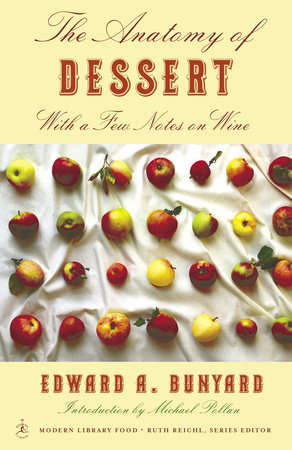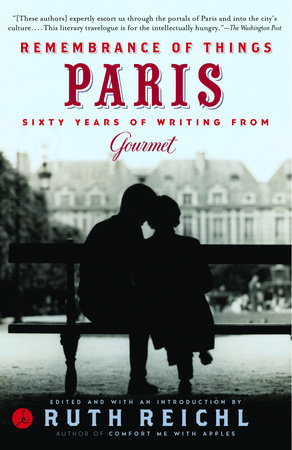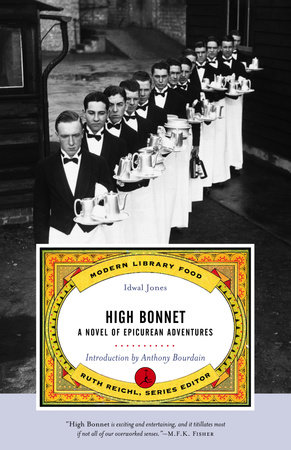Excerpt
The Anatomy of Dessert
Apples
No fruit is more to our English taste than the Apple. Let the Frenchman have his Pear, the Italian his Fig, the Jamaican may retain his farinaceous Banana, and the Malay his Durian, but for us the Apple.
In a careful pomological study of my fellow-men I have met but one who really disliked apples, but as he was a Scotsman born in Bavaria, educated in England, domiciled in Italy, he is quite obviously ruled out.
What fruit can compare with the Apple for its extended season, lasting from August to June, keeping alive for us in winter, in its sun-stained flush and rustic russet, the memory of golden autumnal days?
Through all the seven ages of man it finds a welcome, and we now learn that not only does it keep the doctor from our doors but ourselves from the dentists.
Is there any other edible which is at once an insurance, a pleasure, and an economy?
Before discussing the best dessert apples let us dismiss the popular error that a single test is sufficient for a fair judgement of a fruit. Often one hears the phrase, “I tasted so-and-so and did not think much of it.” Flavour depends much upon the season, and many varieties require a really hot summer to develop their highest qualities. The Reinettes, such as Blenheim Orange, Cox’s Orange, Orleans Reinette, and most of the russets, have their vintage years, of which 1921 will remain long in the memory. All varieties, too, have their optimum moment of aroma and also of acidity. A Cox’s in October is a little too acid, but as the acid gradually fails, the aromatic ethers develop, and the end of November and early December see them at their height. It then slowly declines, very slowly if properly stored, and even in May, after a sunny summer, it is still worthy.
To Mr. Cox, a retired brewer, we owe this “good creature,” as Mr. Saintsbury would call it, and we can picture the scene at Colnbrook Lawn, Slough, in 1825. Mrs. Cox would have drawn up her chair by the fire, the evenings are turning a little chilly, while Mr. Cox, who dines at four, is lingering over his port and dessert.
“Ah, my dear, now this is what I call a good apple. Yes, yes, very good.”
“Pray, is it one of your old seedlings?” says Mrs. Cox, always a little scornful of home productions.
“On the contrary, it is one of my new ones.”
“Ah well, I don’t see how it can be better than a Ribston.”
The firelight plays on the cut-glass decanter, and a slight reflection answers on Mr. Cox’s nose, as he smiles his wise old man’s smile and thinks how women are all alike—and so a great moment in history slips by.
But perhaps Mr. Cox was a bachelor. . . .
There is in the Apple a vast range of flavours and textures, and for those who adventure in the realm of taste, a field for much hopeful voyaging.
The nomenclature of flavour is more scanty than even that of colour. How can we describe a fruit as of high flavour when this adjective by long use has gained a special significance as applied to game? All pomologists have felt this difficulty, the German with his süsser Geschmack, the native of France with his use of parfumée, vineuse, etc., and our own eighteenth-century writers whose phrase, a “delicate haut gust,” though it charms the ear, conveys little to the mind. We must fall back, therefore, on the fruits themselves, and try to discern some genera of flavours, a gustatory classification.
First we must rule out the merely sweet or sour, these are not flavours though important adjuncts. Acidity for culinary fruits is of primary importance, as it is to this that their capacity for turning soft is due; those varieties which cook only to a woody texture can be brought to a normal softness by the addition of an acid such as lemon juice.
Much has been written against the “large sour apples” used generally for cooking, and varieties which “provide their own sugar” recommended in their stead. Every apple, however, is sour in its youth, and the acid gradually disappears as ripening proceeds, taking, as is natural, longer in late varieties than in the early. If, then, an apple is too sour, it merely means that it has been used too early. It is perhaps hardly necessary to point out that sourness tempered with sugar is not the same as mere lack of acidity.
In dessert apples it is noticeable that all the most esteemed sorts have a good proportion of acid, and it is the blend of this sweetness and flavour that renders them attractive, the merely “sweet” being as nauseous as in human-kind.
The right season to eat an apple is a matter of importance; to catch the volatile ethers at their maximum development, and the acids and sugars at their most grateful balance requires knowledge and experiment. Many apples will keep far beyond their period of maximum flavour, and in some this moment is so fleeting that they are hardly worth growing; a week-end away from home might prove disastrous. Times and seasons are therefore but rough guides to the correct moment; experiment alone can decide. An incontinent friend eats his Ribstons direct from the tree, and has at least convinced me that we do, in fact, place too late a season for this admirable fruit. It should be tested frequently after gathering, and will generally be found to be best used before Cox’s come in in November.
In flavours we can discern a few main groups, and the early apples mostly have what has been called the Strawberry or Raspberry flavour, Worcester Pearmain, Duchess of Oldenburgh, Emperor Alexander being notable examples. The first-named fruit, however, must not be judged from barrow or shop samples, which are usually gathered far before they are ripe, and both in texture and flavour are to be passionately avoided. The really ripe Worcester has character, and, though far from the supreme heights, is in its season acceptable and the Raspberry flavour distinctive.
A second class will be the Blenheim flavour, a nutty, warm aroma which is to my taste the real apple gust; in fact, I take a Blenheim as a test case. The man who cannot appreciate a Blenheim has not come to years of gustatory discretion; he probably drinks sparkling Muscatelle. There is in this noble fruit a mellow austerity as of a great Port in its prime, a reminder of those placid Oxford meadows which gave it birth in the shadow of the great Palace of Blenheim. Like Oxford, too, it adopts a leisurely pace, refusing to be hurried to maturity or to relinquish its hold on life. An apple of the Augustan Age.
What can Cambridge put by its side? Its thin and acid airs have produced only a Histon Favourite, an apple of no period, indiscriminate and undistinguished.
The Blenheim qualities are shared by few, Orleans Reinette is its most notable analogue. Similar in appearance with an added spice as of the Ribston, this stands of all apples highest in my esteem. Much of its Blenheim nuttiness is found in Egremont Russet, while Woodstock Pippin, Ballinora, and a few others share its qualities in some degree.
A third flavour group is that of the Russets which have a peculiar “fennel” flavour; Brownlee’s Russet and Reinette Grise de St.-Ogne show this in marked degree, while the French group of Fenouillets are named from this special gust.
The highly spiced flavour of Cox’s Orange stands as a type, and into this group would come Ribston and Margil and a few of the Cox descendants, such as St. Everard, Houblon, and Rival. Like all classifications these divisions at once reveal their inadequacy when we consider the outsiders so far unplaced. Where shall we put James Grieve with its faint Cox flavour, Allington Pippin in whose “gelid pores” Mr. Eden Phillpotts discerned pine and grape, “the scent of quince and pear, breath of honey from the hive”?
No! Genera and classes are a vanity and can be disproved at every turn, but let them stand, critics must live.
In the matter of textures matters go more smoothly. We can well contrast the smooth, almost marrow-like flesh of James Grieve with the crisp glassiness of May Queen, which breaks with a crack as you bite it, the cassant or croquant flesh of French writers. The Russets when fully ripe are soft, as is also the Blenheim, a grain suggesting warmth, while the crisp-fleshed varieties taste distinctly colder. Cox becomes quite soft, and yet not dry, in its later stages, and those whose dental powers owe more to art than to nature, may well keep their Cox’s till March. To the young, however, the crunch is the thing, a certain joy in crashing through living tissue, a memory of Neanderthal days. For them the Quarrendens and Kerry Pippins, which a far-seeing Providence has ordained to ripen in the time of summer holidays.
The need of care in selecting the right moment for each apple becomes more urgent when we consider the early varieties, where this instant of perfection has chosen to be with as great care as in the case of the more temperamental Pear. The first apples, such as Gladstone, Irish Peach, Feltham Beauty, should be eaten from the tree, or at any rate not kept over till the next day, when they will be flat and unprofitable. Of the three named, Irish Peach is to be preferred. Its fresh acidity with slight spicy aroma accords well with the warm August days. White Transparent, though usually cooked, is, at its brief moment, commendable. When ripe it becomes a transparent ivory white and the flesh is soft and yet full of juice. An acute writer has termed it a “before breakfast apple,” and a tree handy to the house will not be unvisited in late July and early August. In Gladstone we have the earliest of apples in our list, quite a good hors-d’Suvre to the apple season, but surely never was a fruit more unsuitably named. Its shining red cheeks and impudent eye lack the dignity rightly associated with the great Liberal leader; now Gloria Mundi, with its severe angles and pallid majesty, would have some claim.
After our first early apples are over a slight pause occurs until St. Everard makes its welcome appearance at the end of August or thereabout. This is a newcomer with much of Cox in its ancestry, and its flavour is a substantial shadow before the coming event. For a limited time quite first class with much of its parental texture and juice, but unfortunately a bad grower. For the Coxomaniac this starts the apple season. At the same time comes Lady Sudeley, an apple which every garden should possess if only for its flaming scarlet fruits. The flesh is tender and melting, and at its hour of prime very highly aromatic and juicy. For the best result it should be gathered before it is willing, and stored in the fruit room for a week or two and sampled from day to day till the exact moment arrives. Grown in an unkindly soil, it can be hard and woody, and has thus lost many admirers. After Lady Sudeley comes James Grieve, in its Midlothian home a Christmas apple, but with us in the Home counties a September fruit. This is one of the very few apples resulting from the marriage of a cooking and a dessert apple which is of dessert quality. One feels that like some of the recently ennobled we know of, it is a near thing, and untoward circumstances such as a cold and sunless summer reveal the humbler origin. But given a fair chance we welcome the newcomer, thankful for the melting, almost marrowy flesh, abundant juice, and fragrant aroma.
October brings us four apples of great distinction, and with Gravenstein and Egremont Russet I should be quite content. Let us, however, add Ellison’s Orange and Rival to our list.
Of Gravenstein it is hard to speak in mere prose, so distinct in flavour is it, Cox itself not standing more solitary, so full of juice and scented with the very attar of apple. This aroma comes out on the oily skin and remains on the fingers despite many washings, bringing to mind the autumnal orchard in mellow sunlight. Strange, indeed, it is that this excellent fruit, coming from Schleswig in 1760 and much grown in this country in the early half of the last century, should have been almost forgotten by gardeners.
The flesh contrives to be crisp without hardness, and it has the remarkable quality of keeping unshrivelled until Christmas and not losing flavour. I place it in this month as it is impossible to delay our enjoyment of it one moment beyond its legitimate ripeness. In parenthesis, it may also be eaten from the tree in September, but this information should be kept a close secret.
In Egremont Russet we have a fruit of superb quality, its abundant juice and remarkable nutty flavour are unapproached in their season.
In Ellison’s Orange is a Cox’s Orange descendant, claiming as the other parent the Calville Blanc, a marriage of the most esteemed dessert apples of England and France. It is with some misgivings that I include the result of this international union. It has, with me, a distinct aniseed flavour, and when I presented it to one educated palate with a request for a description of its flavour, I was told that he was reminded of a chemist’s shop. Against this it is only fair to set the voice of a Midland connoisseur, who would select this variety were he reduced to a single apple. I therefore judge that the aniseed is a product of a warmer climate and am thankful that in a month containing Egremont Russet and Gravenstein no risks need be taken in the south.
Rival is an apple that can hardly be omitted from the collection if only on account of its beauty. A tree of this variety in full fruit, with its almost salmon-carmine tinge and light bloom, is, to an apple lover, irresistible. And why, I may ask, should we not grow fruits for their beauty? The eye requires its food no less than the stomach, and when we can combine these appeals we follow a sound instinct implanted long before modern physiologists discovered it. The brilliance of Gascoyne’s Scarlet with its carmine on ivory, Peasgood’s Nonesuch with its matronly form joined to the fresh colour and bloom of virginity, should decorate the dessert table even though, for interior purposes, we usually prefer them to come to us via the kitchen. But Rival has its fleeting moment of good flavour and can honourably figure at the dessert.








